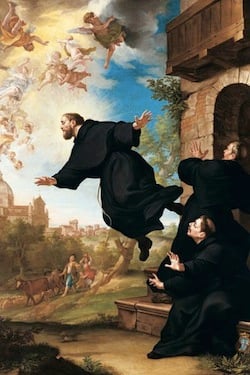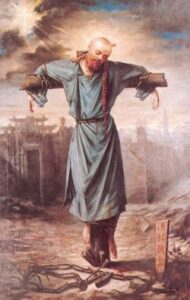 Sts. Anne and Joachim
Sts. Anne and Joachim
Explore the Saints
St. Joseph of Cupertino
After suffering a terrible childhood, St. Joseph of Cupertino became one of the most miracle-prone saints in the Church—he was often totally consumed by prayerful rapture and was even observed levitating.
He was born 1603 in Cupertino, Italy to poor parents. His father was a carpenter, but was unable to make ends meet and had to put the family house up for sale just as his wife came to term—she bore Joseph in a shed behind the house.
Joseph’s father died when he was young, and his widowed mother abused him. Joseph’s development suffered—he had a hot temper, and became absent-minded. Village people knew him was known as “the gaper” around town because he would wander about aimlessly with his mouth open. One thing did consume his attention: he threw himself into devotional practices and grew in his faith.
When he reached maturity, he was apprenticed to a shoemaker, but failed at that position. He applied to several monasteries, but was refused. The Capuchin order accepted him on a trial basis as a lay brother, but he was inept and clumsy—he would drop whole piles of dishes, or forgot his duties, or could not be trusted with even minor responsibilities.
He returned home in a great depression. His mother was not happy to see him, and she pleaded with her brother, who was a Franciscan monk, to have him accepted to his monastery as a servant. He was taken in and given work cleaning out the stables.
The consistent work and community life seemed to suit Joseph, and he became more trustworthy and capable. He had a certain humility and sweetness, and was diligent in his prayer and devotional life—within a few years, he was accepted as a full brother in the community.
Though he struggled in his studies, and had nothing to offer in the way of eloquence, he was ordained a priest in 1628. His devotional life increased, and he took on rigorous fasting and disciplines.
After his ordination, Joseph’s life came in tune with the divine in a new and radical way. He began to experience ecstasies and visions and was a worker of miracles—more than nearly any other saint! He frequently fell into contemplative ecstasy, and could not be awakened with pinches or blows. He was friends to animals in a way that surpassed even St. Francis of Assisi. During Mass or prayer, he would often be lifted from his feet—he was observed levitating more than 70 times.
The experience of levitation is a physical expression of the deep prayer that raises the heart and mind to God. In Joseph’s case, a number of his levitations were well-documented.
In one instance, the Spanish ambassador visited Joseph’s monastery and visited Joseph in his cell. The ambassador told his wife that he had met “another St. Francis,” and she wanted to meet Joseph herself. She asked to meet him in the church, but Joseph, knowing his susceptibility to fall into rapture at even the sight of religious imagery, realized that he might not be able to speak with her.
When he entered the church, Joseph’s eyes fell on an image of Mary, and he was transported by ecstatic prayer and rose more than ten feet off the ground and flew over the heads of those present to the statue of Mary. After praying there, he flew back to the doors of the church and returned to his cell. This story was captured in depositions from eyewitnesses that were gathered for Joseph’s cause for canonization.
Joseph was moved to a monastery in Assisi, and–for a time–was treated severely by his superiors, who thought him a hypocrite or suspected he was pretending. During his time in Assisi he was visited by many prominent religious and political figures who heard of his holy miracles and took up correspondences with notable figures of his day.
“Pray,” he told everyone. “Pray. If you are troubled by dryness or distractions, simply say the Our Father. Then you make both vocal and mental prayer.”
The marvels that accompanied Joseph became a distraction to both the monastery and to others who came seeking novelty, so he was not allowed to offer Mass or pray in public, or even to eat his meals with his brothers. His order eventually isolated him and he had little contact with other members of his community.
He consented to isolation, and used solitude to commune with God on an even deeper level. He fell ill at the age of 60 and died on this date in 1663 at a Franciscan monastery in Osimo. His relics rest in the reliquary chapel in the Basilica, and he is depicted above in a painting by Ludovico Mazzanti.
St. Joseph of Cupertino, the levitating saint, pray for us!

Search Saints
 Sts. Anne and Joachim
Sts. Anne and Joachim
 St. Robert Bellarmine
St. Robert Bellarmine
 Sts. Cornelius and Cyprian
Sts. Cornelius and Cyprian
 Our Lady of Sorrows
Our Lady of Sorrows
 The Exaltation of the Holy Cross
The Exaltation of the Holy Cross
 St. John Chrysostom
St. John Chrysostom
 Blessed Victoria Strata
Blessed Victoria Strata
 St. John Gabriel Perboyre
St. John Gabriel Perboyre
 St. Nicholas of Tolentino
St. Nicholas of Tolentino
 St. Peter Claver
St. Peter Claver
 Feast of the Birth of Mary
Feast of the Birth of Mary
 St. Cloud
St. Cloud
 St. Eleutherius
St. Eleutherius
 St. Teresa of Calcutta
St. Teresa of Calcutta
 St. Rose of Viterbo
St. Rose of Viterbo
 Pope St. Gregory the Great
Pope St. Gregory the Great
 Blessed Jean-Marie du Lau and the Martyrs of September
Blessed Jean-Marie du Lau and the Martyrs of September
 St. Anna the Prophetess
St. Anna the Prophetess
 St. Pammachius
St. Pammachius
 Feast of the Beheading of John the Baptist
Feast of the Beheading of John the Baptist
 St. Augustine
St. Augustine
 St. Monica
St. Monica
 Our Lady of Czestochowa
Our Lady of Czestochowa
 St. Louis of France
St. Louis of France



